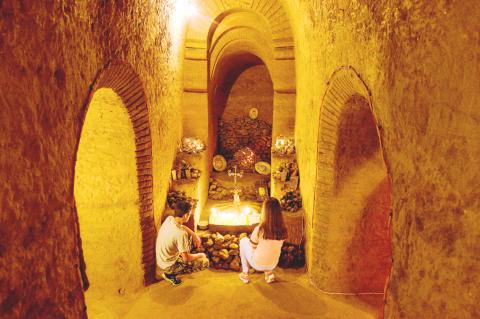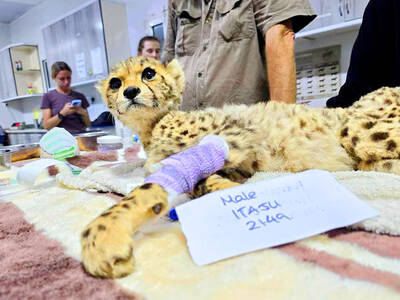When Tosya Gharibyan asked her husband to dig a basement under their house to store potatoes, she had little idea that the underground labyrinth he would eventually produce would prove to be one of Armenia’s major tourist draws.
Their one-story house in the village of Arinj outside the capital, Yerevan, might not look like much, but today it brings in visitors from all over the globe after a 23-year labor of love by Tosya’s late husband, Levon Arakelyan.
They come to see a twisting network of subterranean caves and tunnels known as “Levon’s divine underground.”

Photo: AFP
In the cold and quiet, Tosya leads tourists through corridors that connect seven chambers adorned with Romanesque columns and ornaments like those on the facades of medieval Armenian churches.
“Once he started digging, it was impossible to stop him,” she said of the project that began in 1985. “I wrangled with him a lot, but he became obsessed with his plan.”
A builder by training, Levon would toil for 18 hours a day — only pausing to take a quick nap, and then rush back to the cave, confident that he was being guided “by heaven.”
“He never drew up plans and used to tell us that he sees in his dreams what to do next,” Tosya said.
Over more than two decades, he hammered out the 280m2 space, 21m deep into strata of volcanic rocks — only using hand tools.
“My primary childhood recollection is the loud knock of my father’s hammer heard at night from the cave,” said his daughter, Araksya.
At the start he had to break through a surface layer of black basalt, but after a few meters, Levon reached much softer tufa stone and the work progressed.
He pulled out 600 truckloads of rocks and earth, using only hand-held buckets.
Levon died in 2008 at the age of 67 from a heart attack after destroying the last wall that separated two tunnels.
A decade after the project’s completion, Tosya also runs a small museum commemorating her husband’s work in the village of about 6,000 people.
The underground complex has several analogues in the world.
An eccentric man named William Henry “Burro” Schmidt spent more than three decades digging an 805m tunnel to transport gold through a granite mountain in California, beginning his work in the early 1900s during the state’s gold rush.
In Ethiopia, a man named Aba Defar began carving churches on a mountainside after claiming divine inspiration from years of dreams.
Today, the Armenian cave features prominently in travel brochures, regularly drawing visitors.
Milad, a 29-year-old Iranian tourist, called the maze an “amazing place,” saying it made him realize just “how boundless the spiritual and physical capabilities of a person can be.”

ELECTION DISTRACTION? When attention shifted away from the fight against the militants to politics, losses and setbacks in the battlefield increased, an analyst said Recent clashes in Somalia’s semi-autonomous Jubaland region are alarming experts, exposing cracks in the country’s federal system and creating an opening for militant group al-Shabaab to gain ground. Following years of conflict, Somalia is a loose federation of five semi-autonomous member states — Puntland, Jubaland, Galmudug, Hirshabelle and South West — that maintain often fractious relations with the central government in the capital, Mogadishu. However, ahead of elections next year, Somalia has sought to assert control over its member states, which security analysts said has created gaps for al-Shabaab infiltration. Last week, two Somalian soldiers were killed in clashes between pro-government forces and

Ten cheetah cubs held in captivity since birth and destined for international wildlife trade markets have been rescued in Somaliland, a breakaway region of Somalia. They were all in stable condition despite all of them having been undernourished and limping due to being tied in captivity for months, said Laurie Marker, founder of the Cheetah Conservation Fund, which is caring for the cubs. One eight-month-old cub was unable to walk after been tied up for six months, while a five-month-old was “very malnourished [a bag of bones], with sores all over her body and full of botfly maggots which are under the

BRUSHED OFF: An ambassador to Australia previously said that Beijing does not see a reason to apologize for its naval exercises and military maneuvers in international areas China set off alarm bells in New Zealand when it dispatched powerful warships on unprecedented missions in the South Pacific without explanation, military documents showed. Beijing has spent years expanding its reach in the southern Pacific Ocean, courting island nations with new hospitals, freshly paved roads and generous offers of climate aid. However, these diplomatic efforts have increasingly been accompanied by more overt displays of military power. Three Chinese warships sailed the Tasman Sea between Australia and New Zealand in February, the first time such a task group had been sighted in those waters. “We have never seen vessels with this capability

‘NO INTEGRITY’: The chief judge expressed concern over how the sentence would be perceived given that military detention is believed to be easier than civilian prison A military court yesterday sentenced a New Zealand soldier to two years’ detention for attempting to spy for a foreign power. The soldier, whose name has been suppressed, admitted to attempted espionage, accessing a computer system for a dishonest purpose and knowingly possessing an objectionable publication. He was ordered into military detention at Burnham Military Camp near Christchurch and would be dismissed from the New Zealand Defence Force at the end of his sentence. His admission and its acceptance by the court marked the first spying conviction in New Zealand’s history. The soldier would be paid at half his previous rate until his dismissal